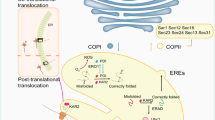Abstract
Recombinant Escherichia coli strain C600/pBV-TRAIL (encoding for 114-281 amino acids of TRAIL's soluble fragment) produced a recombinant human tumor necrosis factor-related apoptosis-inducing ligand (Apo2L/TRAIL). Using a combined strategy of exponential feeding and pH-stat feeding, high concentrations of biomass (65 g dry wt l−1) and active soluble TRAIL (1.4 g l−1) were obtained within 30 h. The accumulation of acetate, which usually occurs during the process of high-density culture of Escherichia coli and especially in the induction stage of protein synthesis, was avoided.
Similar content being viewed by others
References
Castan A, Enfors SO (2000) Characteristics of a DO-controlled fedbatch culture of Escherichia coli. Bioproc. Eng. 22: 509–515.
Laemmi UK (1970) Cleavage of structural proteins during the assembly of the head of bacteriophage T4. Nature 227: 680–685.
Lee SY (1996) High cell-density culture of Escherichia coli. Trends Biotechnol. 14: 98–105.
Pan JG, Rhee JS, Leheault JM (1987) Physiological constraints in increasing biomass concentration of Escherichia coli B in fedbatch culture. Biotechnol. Lett. 9: 89–94.
Schmidt M, Babu KR, Khanna N, Marten S, Rinas U (1999) Temperature-induced production of recombinant human insulin in high-cell density cultures of recombinant Escherichia coli. J. Biotechnol. 68: 71–83.
Seeger A, Schneppe B, McCarthy JEG, Deckwer WD, Rinas U (1995) Comparison of temperature and isopropyl-â-D-thiogalacto-pyranoside-induced synthesis of basic fibroblast growth factor in high-cell-density cultures of recombinant Escherichia coli. Enzyme Microb. Technol. 17: 947–953.
Walczak H, Miller RE, Arial K, Gliniak B, Griffith TS, Kubin M, Chin W, Jones J, Woodward A, Le T, Smith C, Smolak P, Goodwin RG, Rauch CT, Schuh JCL, Lynch DH (1999) Tumoricidal activity of tumor necrosis factor-related apoptosis-inducing ligand in vivo. Nat. Med. 5: 157–163.
Wiley SR, Schooley K, Smolak PJ, Din WS, Huang CP, Nicholl JK, Sutherland GR, Smith TD, Rauch C, Smith CA (1995) Identification and characterization of a new member of the TNF family that induces apoptosis. Immunity 3: 673–682.
Yin L, Jian C, Ying YM, Shi YL, Yoon MK (1998) Effect of additives and fed-batch culture strategies on the production of glutathione by recombinant Escherichia coli. Proc. Biochem. 33: 709–714.
Author information
Authors and Affiliations
Rights and permissions
About this article
Cite this article
Shen, YL., Zhang, Y., Sun, AY. et al. High-level production of soluble tumor necrosis factor-related apoptosis-inducing ligand (Apo2L/TRAIL) in high-density cultivation of recombinant Escherichia coli using a combined feeding strategy. Biotechnology Letters 26, 981–984 (2004). https://doi.org/10.1023/B:BILE.0000030043.84226.ac
Issue Date:
DOI: https://doi.org/10.1023/B:BILE.0000030043.84226.ac




